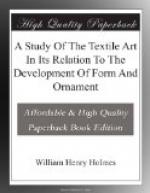324. Coiled basket with geometric ornament 221
325. Coiled basket with geometric ornament 223
326. Coiled tray with geometric ornament 224
327. Coiled tray with geometric ornament 225
328. Tray with geometric ornament 225
329. Tray with geometric ornament 226
330. Ornament produced by wrapping the strands 227
331. Ornament produced by fixing strands to the surface of the
fabric 227
332. Basket with feather ornamentation 227
333. Basket with feather ornamentation 227
334. Piece of cloth showing use of supplementary warp and woof 228
335. Piece of cloth showing use of supplementary warp and woof 228
336. Example of grass embroidery 230
337. Example of feather embroidery 231
338. Figures from the Penn wampum belt 233
339. Figures from a California Indian basket 234
340. California Indian basket 234
341. Figures from a Peruvian basket 235
342. Figure from a piece of Peruvian gobelins 236
343. Figures from a Peruvian vase 237
344. Figure from a circular basket 238
345. Figure of a bird from a Zuni shield 239
346. Figure of a bird woven in a tray 240
347. Figure of a bird woven in a basket 241
348. Figures embroidered on a cotton net by the ancient
Peruvians 242
349. Figures of birds embroidered by the ancient Peruvians 243
350. Conventional design painted upon cotton cloth 243
351. Herring bone and checker patterns produced in weaving 246
352. Herring bone and checker patterns engraved in clay 246
353. Earthen vase with textile ornament 247
354. Example of textile ornament painted upon pottery 248
355. Textile pattern transferred to pottery through costume 248
356. Ceremonial adz with carved ornament of textile character 250
357. Figures upon a tapa stamp 251
358. Design in stucco exhibiting textile characters 251
TEXTILE ART IN ITS RELATION TO THE DEVELOPMENT OF FORM AND ORNAMENT.
By William H. Holmes.
INTRODUCTION.
The textile art is one of the most ancient known, dating back to the very inception of culture. In primitive times it occupied a wide field, embracing the stems of numerous branches of industry now expressed in other materials or relegated to distinct systems of construction. Accompanying the gradual narrowing of its sphere there was a steady development with the general increase of intelligence and skill so that with the cultured nations of to-day it takes an important, though unobtrusive, place in the hierarchy of the arts.




